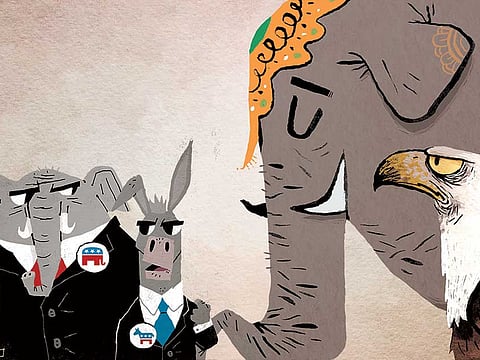The next US president should keep India close
Youngest populations and solid democratic foundations make both best positioned for global influence far into this century

When this bitter, divisive American presidential campaign mercifully comes to an end in November, the victor will face the Olympian task of restoring flagging public and congressional support for strong United States leadership in the world.
A truth once undisputed in American politics — that US global primacy is beneficial for the country — is now under assault. Bernie Sanders’s narrow, pessimistic view of America’s great-power future has encouraged twin scourges of protectionism and isolationism on the Left. Donald Trump’s fearful, fact-free campaign has been infinitely more damaging in stoking isolation and nativism on the right. Hillary Clinton alone has held up the banner that all post-Second World War presidents have carried — one of US engagement and global leadership.
When Indian Prime Minister Narendra Modi visits the White House today, Republicans and Democrats will have a chance for redemption by lending bipartisan support for such leadership — in the form of an ambitious strategic partnership with India and its 1.25 billion people.
This project, carefully engineered by the past three presidents, is arguably one of the most important US foreign policy advances in decades. Bill Clinton broke the ice by suggesting the US’ 21st-century global interests were in alignment with India’s. George W. Bush made the major push forward by negotiating a civil nuclear agreement between the two countries and persuading both parties in Congress to remove sanctions. Barack Obama became the first President to support India for a permanent seat on the United Nations Security Council.
This rare, long-term strategic initiative by three administrations in an increasingly fractious Washington is a testimony to what can be accomplished when Republicans and Democrats act in unison to serve America’s national interest.
When Modi and Obama meet in the Oval Office, the glue that will bind them together is their mutual concern about a newly assertive China in Asia. Both face the same dilemma. They have no choice but to engage China on trade, global economic stability and climate change, given Beijing’s vast international weight and influence. At the same time, Washington and New Delhi understand the necessity of standing up to China’s bullying of Vietnam, the Philippines and other claimants to the Spratly and Paracel islands in the South China Sea.
This is one reason America’s emerging triangular military partnership with India and Japan is so important. While not designed to contain China in a conventional sense, growing air and sea cooperation among the three democracies can help to prevent a strengthening People’s Liberation Army from dominating the Asia-Pacific region in this century. US Defence Secretary Ashton B. Carter has been particularly effective in laying the groundwork for a more integrated US military future with India.
On a recent visit to New Delhi, I was struck by a change of attitude among senior Indians who have long debated how much they should strengthen ties with the US, given India’s traditional non-alignment. That debate is clearly shifting. Modi is seeking stronger strategic links to Obama and his successor. In fact, this “foreign policy prime minister”, as many call him, aims to transform India itself from the dominant country in South Asia to a true world power. That goal mirrors Obama and Bush’s calculation that a strong India is in America’s interest. Republican and Democratic leaders should continue to support it.
America’s relationship with New Delhi is far from untroubled. The civil nuclear deal has still not been implemented due to unfair legislative barriers in New Delhi. Washington is wary of India’s rapidly warming ties with Iran, while New Delhi wants the US to consult it more actively on Afghanistan. The two governments remain uneasy partners on climate change. Modi’s much-heralded economic reforms have been fitful, at best. And the US remains far apart on global trade due to India’s austere protectionism, which excluded it from the Trans-Pacific Partnership negotiations.
Still, long-term trend lines are auspicious. India and the US have the two youngest populations of all the great powers. By virtue of their solid democratic foundations, they may be best positioned for global influence far into this century. The next US president and Congress should push joint efforts in cyber and homeland security, clean energy, the digital revolution and the emerging global strategic health campaign.
Trump has been wrong about many things in this campaign, most notably in insisting that the US doesn’t win anymore. The strengthening partnership with India is a striking success. It has been built by the internationalist centre in both parties that can still unite them on important foreign policy issues. The next US president will have the opportunity to work with Republicans and Democrats in writing the next chapter with India. He or she should take it.
— Washington Post
Nicholas Burns, a professor at Harvard University, was US undersecretary of state for Political Affairs from 2005 to 2008. He is also an adviser to Hillary Clinton’s presidential campaign.
Sign up for the Daily Briefing
Get the latest news and updates straight to your inbox



